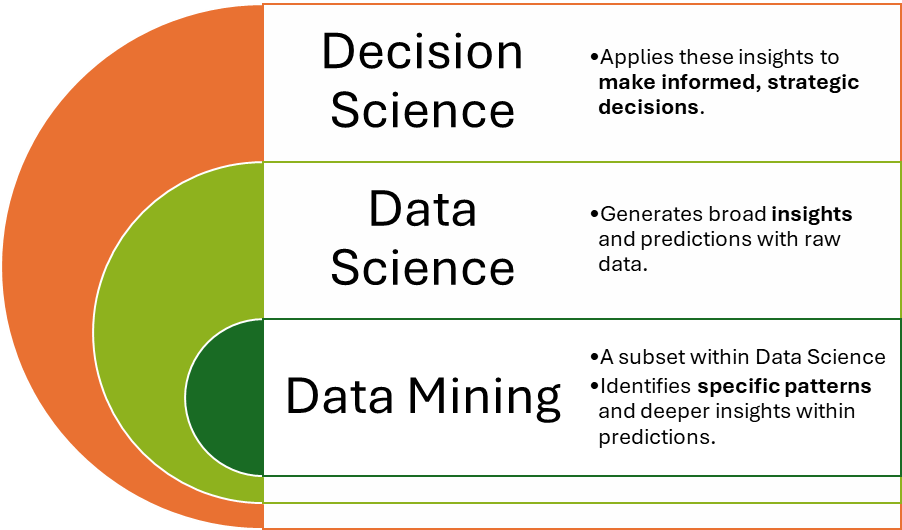Decision Science, Data Science and Data Mining – Key Distinctions & Applications
- Derrick Yuen, MBA

- May 5, 2024
- 3 min read

In the rapidly evolving world of data-driven decision-making, technology, terminology, methods and definitions have been evolving. When I first got into the data space more than a decade ago, “Data Analytics” was the prevailing term; even then it was old wine in new bottles. I was a business analyst long before the term “Data Analytics” was coined. It was come a long way since.
In the context of the data value chain today, understanding the nuances and relationships between decision science, data science, and data mining is crucial to create sustainable value from data; but are sometimes used interchangeably to the confusion and detriment of many practitioners and organizations. We will attempt to clarify these distinctions, explain their interrelationships, and guide on their effective application.
Data Science: The Foundation of Data Driven Insights
Data science is an interdisciplinary field that uses scientific methods, processes, algorithms, and systems to extract knowledge and insights from structured and unstructured data. It involves various stages of data processing, from cleaning and analysis to predictive modeling. Data scientists use statistical and machine learning techniques to solve complex problems and derive actionable insights from data.
Data science is applicable in scenarios requiring a comprehensive analysis to understand patterns, trends, and predictions. It is crucial in industries like finance, healthcare, marketing, and tech, where large volumes of data are generated.
Data Mining: Unearthing Hidden Patterns
Data mining is a specific subset of data science focused on discovering patterns in large datasets. It employs techniques such as clustering, classification, regression, and association rule learning to explore data at a granular level. Data mining helps identify correlations and patterns that might not be evident on a superficial analysis.
Data mining is particularly useful when you need to discover unknown relationships in data. It’s extensively used in market basket analysis, fraud detection, customer segmentation, and recommendation systems.
Decision Science: Bridging Data with Decision Making
Decision science is the application of quantitative and logical techniques to inform decision-making processes. It integrates data analysis, behavioral science, and managerial insights to make informed decisions that align with organizational goals. Decision scientists use the outcomes from data science to inform strategies, optimize operations, and mitigate risks.
Decision science is essential when strategic decisions need to be made, especially under uncertainty. It is widely used in fields such as business strategy, risk management, operations, and resource allocation.
Respective roles along the data value chain
While data science provides the tools and techniques for data analysis, data mining delves deeper to explore specific patterns and insights within large sets of data. Decision science then takes these insights and applies them within a strategic framework to guide actionable decisions.
Together, these disciplines form a continuum along the analytics value chain:
1. Data Science generate broad insights and predictions with raw data.
2. Decision Science applies these insights to make informed, strategic decisions.
3. Data Mining identifies specific patterns and deeper insights within predictions.
Organizations looking to build sustainable data capabilities must recognize the distinct but interconnected roles each discipline plays. Embracing and building the right capabilities these fields can dramatically enhance your ability to make informed decisions and maintain a competitive edge in today’s data-driven economy.
Next Steps
If you’re interested in deepening your understanding or want to develop capabilities in decision science, data science, or data mining, contact FYT Consulting. Our experts are ready to help you navigate the complex landscape of data-driven decision-making and ensure your organization leverages data at every level for optimal results.
Our tailored approach ensures that you not only understand the theories behind each discipline but also know how to apply them practically to solve real-world problems. Reach out to us today to learn more and start your journey towards becoming a data-driven leader in your industry.
































Comments